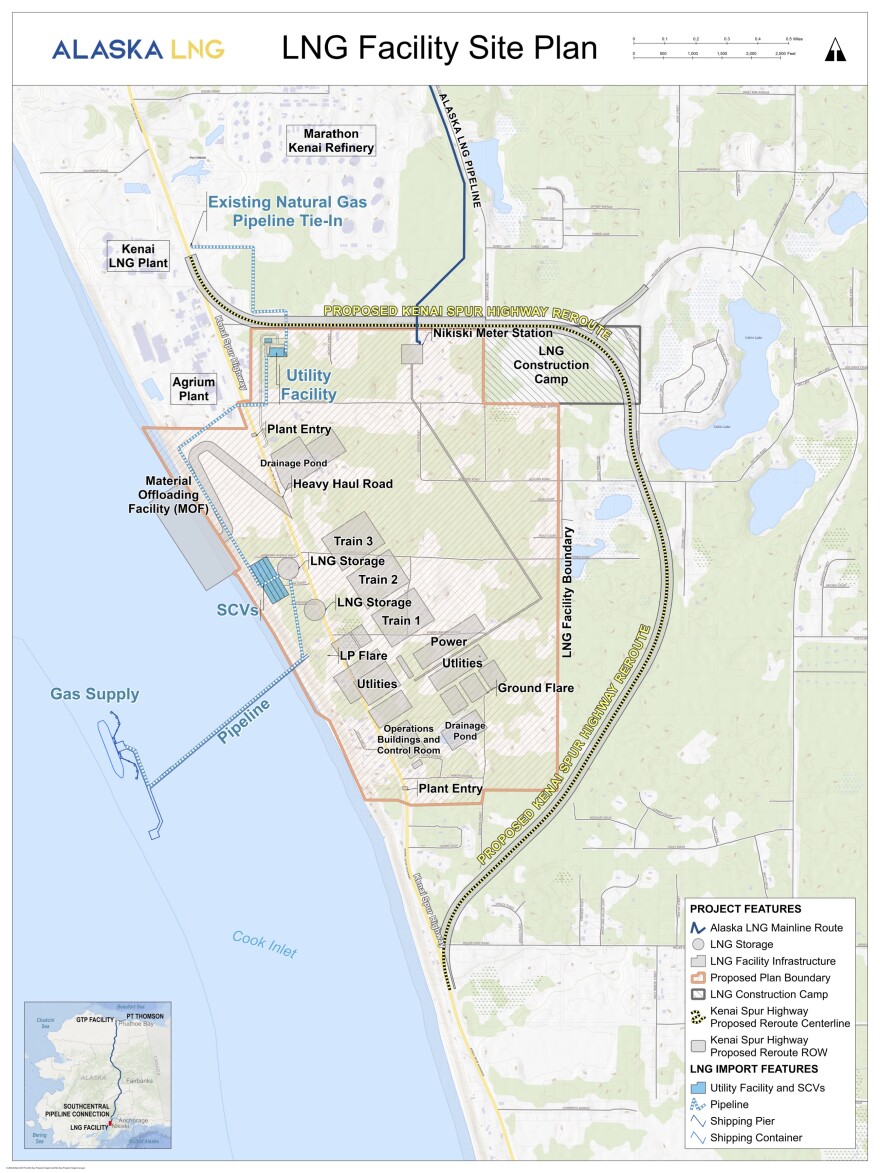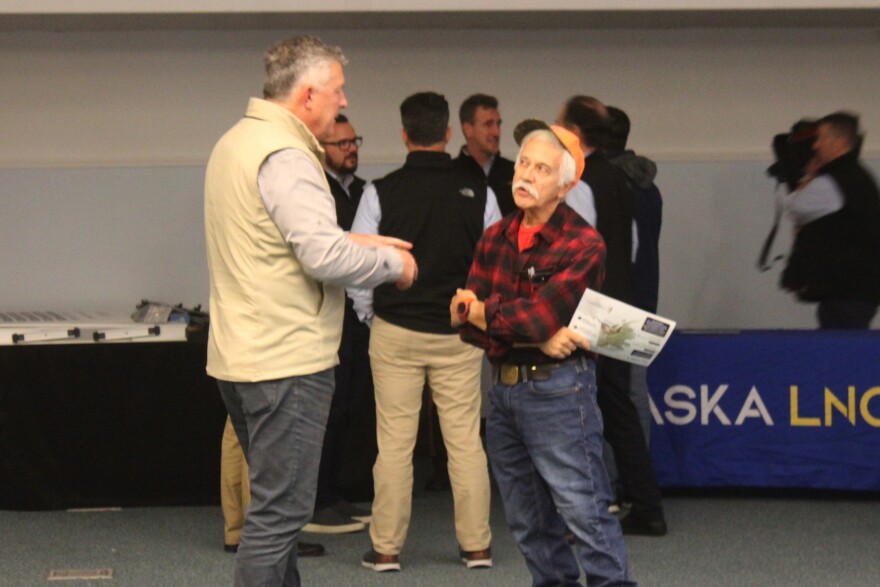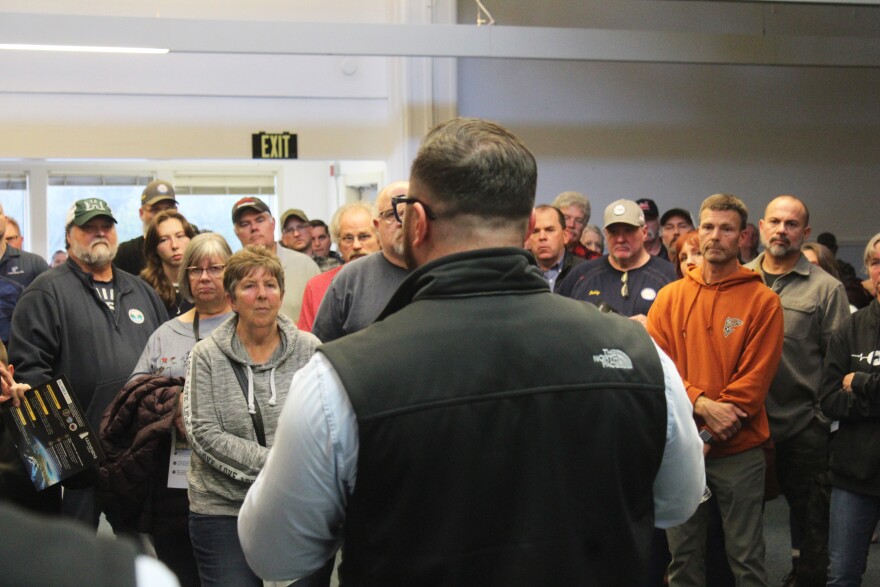Blustery winds and a resulting power outage didn't stop well over 100 people from packing into Nikiski's community recreation center Wednesday. That's where Alaska LNG Project developers fielded questions from residents and presented their strategy for getting natural gas out of the North Slope.
The banquet hall at the Nikiski recreation center was so packed with people you could barely see the informational poster boards along the walls. The power was out, so the room was only partially lit thanks to generators. A sea of faces surrounded a small group wearing Glenfarne-branded jackets. Adam Prestidge led the discussion.
"We know that a project of this magnitude really can't go forward without local buy-in," he said. "Tonight was just a testament of what we saw when we came into the project, which is, yeah, this is a supportive community that's going to help us get this project built."

Prestige is the project president under Glenfarne Group, which assumed majority ownership from the state earlier this year.
If it's built, the $44 billion Alaska LNG Project will move natural gas from Alaska's North Slope through an 800-mile pipeline to Nikiski to be liquefied and shipped overseas. The proposed project terminus is a five-minute drive from the recreation center.
Although Glenfarne is new on the scene, the project is far from a new idea. It's been floated for decades, as many in the oil and gas hub of Nikiski can tell you.
Robin Bogard has lived in Alaska longer than it's been a state. He's a former oil and gas worker who raised five kids with his wife in Nikiski. He's retired now.
"I've supported a gasline for, I'd say, since the late 70s, when the oil pipeline got finished," he said.
But like others who've seen the project try – and fail – to cross the finish line over the years, he has doubts about whether this time is the charm.
"It's a good selling point to come to the local community and say, 'Hey, we're going to bring a project and it's going to bring your utilities down,'" he said. "That sounds good, but how do you make that happen? And I get it, it's early in the project, but just looking at it from a high level, I don't see how that is a realistic, achievable target."
Bogard says he attended the town hall with some questions he wants answered. For example, he owns property near the project footprint and wants to know how he'll be impacted. But he also wants to know how Glenfarne's iteration of the project will pencil out.
"To bring this natural gas from subsurface to surface, put it into a pipeline, shove it 760 miles, and sell it for cheaper than the natural gas that's within the Cook Inlet basin?" he said. "My skepticism is that cost, that distance to bring the same product at a cheaper cost – it can be done, it can be brought here – but at a cheaper cost? I don't see it. I just cannot see it being cheaper."
Prestidge says the current demand for Cook Inlet natural gas is making the supply more valuable, and more expensive. He says that's going to make gas from the project cheaper than whatever price Cook Inlet gas has climbed to by the time the project comes online.
Bogard says it feels significant that Glenfarne is meeting with Nikiski residents, and that the company shouldn't underestimate the impact public opinion will have on the project's success or failure.

Standing in the crowd with Bogard is Kenai City Manager Terry Eubank. Kenai has long supported industrial operations in Nikiski – there are dense housing opportunities, grocery stores and more schools than are available in Nikiski.
Eubank says Glenfarne's team wasn't able to meet with Kenai employees this trip, but he wants the company to know Kenai has a lot to offer them – from city water, to professional development space and the municipal airport.
"The city of Kenai has a lot of resources that in the past the project planned to use, and that we think we can bring to the table," he said. "But I think what we need is some adequate time to do some planning and make sure it's done the right way."
Kenai Mayor-elect Henry Knackstedt agrees.
"It certainly is hard to develop a program if you don't know what the program is that they need, but one of the things that we are doing that is happening at about the right time here is the runway of the airport is going to be completely rebuilt next summer," he said. " … It will be ready for them or for whatever is coming."
Ben Boettger also attended the town hall. He's the energy policy analyst for Cook Inletkeeper. That's the Homer-based nonprofit that advocates for the protection of Cook Inlet's watershed. They're concerned about the project's environmental impacts, with Boettger estimating the project could roughly triple Alaska's annual carbon emissions over its lifetime.
"I mean I'm not going to ask the Alaska Gasline Development Corporation not to develop the Alaska gasline," he said. "That's like, kind of futile. But I don't think they should."
Boettger says there's also harm in the way the pipeline is "warping" the way state leaders make decisions about energy, like putting off renewable energy projects while the pipeline is a possibility. He says Alaskans cannot control the geopolitics driving the pipeline's success or failure. But he says they do have influence over what local utilities do in the meantime.

"It's much harder to write those checks and be confident that they are making the right decision when you're seeing in your other eye a potential future where there's a North Slope gas pipeline," he said.
Glenfarne's Prestidge points to the more than 5,000 permits the project's already acquired as proof that Glenfarne is adhering to high environmental standards. Project leaders have consistently argued the project is a net positive for the environment because it will displace higher-emitting facilities in other parts of the world.
Prestidge doesn't fault people for being skeptical about the project's success. But he expects the skepticism to "fall away" as the project advances.
"We think that all of the pieces of the puzzle are lined up for this project to go forward in a way that has never existed over the past few decades," he said. "And what I'll say is that skepticism needs to be replaced as we make progress."
Wednesday's town hall came the day after the company shared project specifics to state lawmakers. And on Thursday's agenda was another presentation to state business leaders. But Prestidge says there's something special about Nikiski.
"It's a really cool thing to be here, particularly just down the road from Kenai LNG, which was the cradle of the global LNG industry," he said. "So it's pretty amazing to be back here developing this project."
Copyright 2025 KDLL

